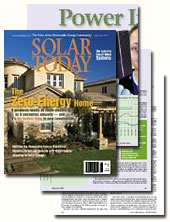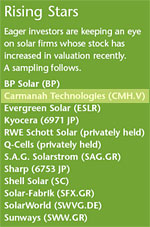By Rona Fried, Ph.D.
Solar Today
 |
The year 2004 may well be remembered as the watershed for solar energy. Fifty years after the solar cell's invention, the industry finally is showing clear signs that it is tipping toward mass commercialization.
Through solar photovoltaic (PV) technology, which converts sunlight into electricity, the sun is the world's most abundant source of energy. Yet it has been a long road for those who have worked to advance the technology. Though total installed PV capacity remains but a speck on the landscape of energy consumed worldwide, experts predict the solar PV market will quadruple by 2010, from the current $7 billion market to $30 billion. With annual growth rates exceeding 30 percent and expanding profit margins, solar PV is on track to become a fast-growth, profitable industry.
For investors eager for opportunities in this niche, I offer some rising stars to watch.
Demand, Margins Rise
Last year, the world's 24 publicly traded solar companies as a group saw their shares jump almost 185 percent. Customer demand is so high that solar manufacturers are completely sold out and expanding operations to meet demand. Most importantly, many companies achieved profitability in 2004, and more will in 2005. Costs are falling 5 percent a year, resulting in healthy profit margins.
 |
Analysts expect the price of PV-generated electricity to be cost-competitive in five to 15 years, having steadily fallen from 50 times the price of conventional electricity to twice the price. Even without expected new technology breakthroughs, increased manufacturing efficiencies will be the main avenue for cost reduction during this decade.
Every time manufacturing output doubles, the cost of producing PV modules decreases about 20 percent. If 30 percent annual market growth continues, costs will drop by more than 5 percent a year. Factories are cutting costs through increased automation and the use of fewer materials.
But if you compare the cost of PV-generated electricity to the retail cost of electricity rather than the cost of conventional generation, PV is actually competitive in many markets today. In Japan, for example, PV-generated electricity compares favorably with retail rates of 25 cents per kilowatt-hour.
In addition to technology advances, solar technology also is experiencing favorable policy developments such as the Kyoto Protocol, which went into effect in mid-February. Solar enjoys strong government support in countries like Germany and Japan, where much recent growth has been. And U.S. policy support is growing at the state level.
Crystalline PV Turns Heads
To make a solar cell, silicon is melted and shaped into ingots, which are chopped (or sometimes extruded) into thin slices called wafers. The slices are doped with phosphorous and boron and then collector wires are attached, forming a solar cell. Cells, each about the size of a compact disc, are then wired together in a frame with a transparent cover to form a panel (also called a module). Typically, a solar array for a residential rooftop consists of 25 modules, which produces 3 to 4 kilowatts of electricity, at a cost of $20,000 to $25,000.
 |
Most importantly, because crystalline technology is proven to work on a large scale, large companies are comfortable investing the significant capital necessary to build facilities. Investors feel confident that emerging technologies will not eclipse crystalline PV for the remainder of this decade.
For this reason, investors are excited about Evergreen Solar. Evergreen is distinguishing itself in the market by reducing the cost of solar cell production using standard crystalline technology. Its "ribbon technology" extracts very thin ribbons of silicon by melting them rather than chopping them. The less silicon used, the lower the cost, and the higher the revenue margins.
Major Players Emerge
Five manufacturers of PV cells account for 60 percent of the market share. Each of these companies — Sharp, Kyocera, Shell Solar, BP Solar and RWE SCHOTT Solar — earned more than $100 million in solar revenues in 2004.
As the world's largest solar market, Japan is home to many of the world's largest solar companies. These companies have high market caps compared to those of German and U.S. firms, making them attractive investments to institutional investors. Other public companies with greater than $100 million in annual solar revenues are Sanyo, Sekisui Chemical, SolarWorld, Mitsubishi Electric and Asahi Glass. Each of these players should reach $500 million in annual solar revenues by the end of the decade.
In 2004, only two companies with market caps over $1 billion derived more than 10 percent of their operating profits from solar offerings: Sekisui Chemical and Tokuyama. By 2010, the list should include Sharp, Kyocera, Sanyo, SolarWorld and Omron.
During the past year, all of these Japanese companies reached profitability, along with the largest European firms, BP Solar and Shell Solar. Sharp leads the group by a wide margin, with $930 million in annual solar revenues, twice that of any other player. It has an impressive annual growth rate of 63 percent, more than twice the global rate. Sharp has a 27 percent market share and is investing heavily. Each year, solar contributes more to Sharp's overall revenue: 4 percent to 5 percent this year and 6 percent to 7 percent expected next year, when it will be responsible for 9 to 17 percent of operating profit. With increasing economies of scale, margins are expanding.
Kyocera is the most vertically integrated of the large solar players. It enjoys the widest margins, which are set to increase significantly through 2007 as the company continues to reduce costs. Solar accounts for 3 percent of Kyocera's revenues and is expected to grow to 10 percent by 2010.
Solar Pure Plays Set for Breakout
But these companies are not solar "pure plays," since most of their revenue is derived from other business units. Three pure-play companies are positioned for exponential stock price growth based on rapid expansion plans — U.S.- owned Evergreen Solar and German companies SolarWorld and Q-Cells.
Evergreen Solar's ribbon technology is proven at a commercial scale; the key milestone will be reaching profitability, potentially in the next two years. Its stock price has doubled since earlier this year, when Evergreen and Q-Cells announced their joint venture to build a large manufacturing plant in Germany.
SolarWorld, a vertically integrated player, is the largest pureplay company, with a $330 million market cap. Its stock jumped 551 percent in 2004. SolarWorld melts the silicon, makes the ingots, chops them into wafers, manufactures modules and distributes the final panels. More than any other player, SolarWorld is positioned to capture synergies across the supply chain.
Q-Cells, the world's leading manufacturer of PV cells, is planning a much-anticipated IPO this year. The company would come onto the public markets with an estimated $1.2 billion market cap. Q-Cells has demonstrated aggressive growth, strong margins and leading products.
According to Michael Rogol, a solar analyst with CSLA Asia Pacific Markets, "The company I'm most excited about is Q-Cells. It has the potential to be the Netscape of the solar sector. When Netscape went public in 1994, it started the Internet stock boom."
Other public pure-play companies include several small German pure-play module manufacturers, all of which saw their stock price zoom in 2004: Sunways up 255 percent; Solar-Fabrik, up 262 percent; and S.A.G. Solarstrom, up 170 percent.
Carmanah Technologies is another small player that's making a splash — up 105 percent in 2004. The Canadian company, now profitable, combines LEDs (light-emitting diodes) and solar PV into specialty applications.
Considering all this growth, one might think solar PV is simply a bubble in the public market. But investors and bankers observing the strong fundamentals view it as a robust market ready for takeoff. It appears that an amazing innovation's time has finally come.
Rona Fried, Ph.D., is president of SustainableBusiness.com, the online community for green business: daily sustainable business and investor news, Green Dream Jobs, Business Connections and Progressive Investor. Contact her at rona@sustainablebusiness.com. This article excerpted from the special report, "Investing in Solar PV: A Market at the Tipping Point," recently published by Progressive Investor, SustainableBusiness.com's sustainable investing newsletter.
(Editor's Comment: Even though this article is dated. It is so informative as to bear repetition.")